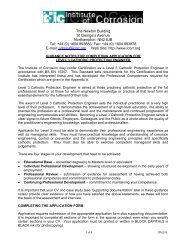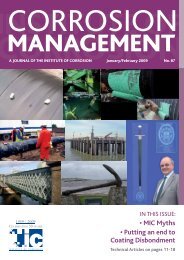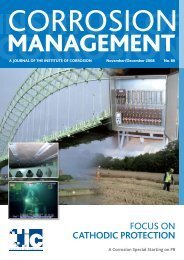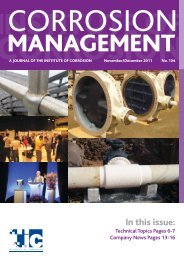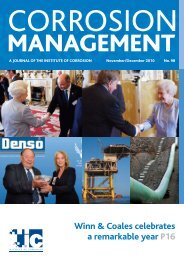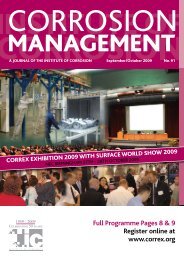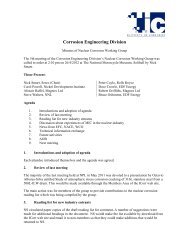In this issue: - the Institute of Corrosion
In this issue: - the Institute of Corrosion
In this issue: - the Institute of Corrosion
You also want an ePaper? Increase the reach of your titles
YUMPU automatically turns print PDFs into web optimized ePapers that Google loves.
TECHNICALARTICLEn <strong>the</strong> surrounding environment and itseffect on durability <strong>of</strong> <strong>the</strong> structure; andn basis and mechanism <strong>of</strong> corrosion andhow and when it occurs.All <strong>of</strong> <strong>the</strong> above are required so that <strong>the</strong>intended design life can be achieved byproviding a design solution to corrosionproblems in <strong>the</strong> marine environment.The reason for selecting <strong>this</strong> case study is that<strong>the</strong> author was responsible for <strong>the</strong> design anddesign management <strong>of</strong> <strong>this</strong> marine structureand ensured that <strong>the</strong> durability <strong>of</strong> structurewas addressed at <strong>the</strong> design stage and not at<strong>the</strong> maintenance stage which is normally toolate and not cost effective.2.0 Case Study2.1 Harriet and NelsonPoint Jetties in PortHedland, AustraliaHarriet and Nelson Point loading Jetties arelocated at Port Hedland (approximately1600 Km from Perth), in Western Australiawhere two new berths will be located ateach jetty with capacity to accommodateCape Class vessels to a maximum <strong>of</strong> 250,000DWT (Dead Weight Tonne) at each berth.The length <strong>of</strong> each jetty is 865m and <strong>the</strong>width is approximately 30m (Figure 1). Therequirement was to design an economicalberthing and loading platform that has adesign life <strong>of</strong> 50 years.Figure 1. Harriet Point Loading Jetty (Image courtesy <strong>of</strong>McConnell Dowell).2.1.1 Selection <strong>of</strong> Materialand Form <strong>of</strong> ConstructionThe question <strong>of</strong> material selection and form<strong>of</strong> construction is crucial for <strong>the</strong> long termcorrosion prevention <strong>of</strong> jetty structures asit is required to withstand <strong>the</strong> extreme loadcombinations while allowing uninterruptedloading <strong>of</strong> iron ore to continue. Therefore,a suitable material needs to be robust totransfer <strong>the</strong> applied load to <strong>the</strong> foundationsas well as retaining service life for 50 years incorrosive marine environment with minimumpreventive measure without significantmaintenance work.There is really no simple rule for choice <strong>of</strong>material in <strong>the</strong> design <strong>of</strong> marine structures,it is normally based on <strong>the</strong> Company ordesigner’s experience on similar projects and:n Cost and <strong>the</strong>ir availability;n Design parameters;n Service life;n Short fabrication and installation time;n Applied load; andn Seabed conditionThe Norsok Standard M-001 which iscommonly used for material selection,recommends that <strong>the</strong> choice <strong>of</strong> materialshall be such that, general, pitting and crevicecorrosions can cost effectively be prevented 7 .This is true but <strong>the</strong> fabrication methodand <strong>the</strong> corrosion rate <strong>of</strong> <strong>the</strong> material areequally important as <strong>the</strong>y both influence <strong>the</strong>corrosion.The construction material for <strong>this</strong> type <strong>of</strong>structure is usually a combination <strong>of</strong> carbonsteel and reinforced concrete members. Themost common Jetty construction consists<strong>of</strong> circular carbon steel piles supporting aconcrete or steel frame deck system 8 and inWestern Australia <strong>the</strong> general approach for<strong>the</strong> construction is a modular constructionwith limited site works. This is to prefabricate<strong>of</strong>fsite a complete section and <strong>the</strong>n transportto site by heavy lift ship or semi-submersiblevessel for final installation. The reason beingthat modular construction provides “highquality” product and fewer defects as it will becarried out under a controlled environment.The construction material for marinestructures differs from country to country.For example <strong>the</strong> author has experiencedthat concrete marine structures are morecommonly used in Hong Kong and PersianGulf countries than say in United Kingdomand Australia and <strong>the</strong> reason behind <strong>this</strong> ispurely economics but <strong>the</strong> marine environment<strong>of</strong> <strong>the</strong>se countries can also be more polluted 9so corrosion prevention <strong>of</strong> steel structuresin polluted marine environments is not verycost effective.2.1.1.1 Choice <strong>of</strong> CarbonSteel as a ConstructionMaterial for main framingand substructureCarbon steel has been chosen for <strong>the</strong> mainframing <strong>of</strong> superstructures and substructures<strong>of</strong> <strong>this</strong> marine structure. The key driver foruse <strong>of</strong> carbon steel for <strong>the</strong> main framing andsubstructure is its versatility to be fabricatedin a form <strong>of</strong> module <strong>of</strong>fsite and inspectedfor any defects during fabrication includingwelds before installation. This is to identifyand eliminate <strong>the</strong> sources <strong>of</strong> corrosion hotspots as well as structural defects. 8&10 Anydefects during fabrication or service lifedue to corrosion ei<strong>the</strong>r in <strong>the</strong> member orjoints will later have a detrimental affect onstability <strong>of</strong> <strong>the</strong> structure or operation <strong>of</strong> <strong>the</strong>facilities. 3,4&52.1.1.2 ModularConstructionModular construction techniques commonlyused in <strong>the</strong> oil and gas industry for decades 10are now being successfully applied to some <strong>of</strong><strong>the</strong> o<strong>the</strong>r large maritime projects undertakenin Australia 8 . After fabrication <strong>of</strong>fshore, wharfmodules are normally transported by heavylift ship to <strong>the</strong> site, transferred onto <strong>the</strong>irfinal positions by <strong>the</strong> ship’s Cranes. Figure 2below shows an example <strong>of</strong> box girder beamswhere <strong>the</strong> weld details can easily be inspectedbefore assembly.The initial motivation for using modularconstruction was because <strong>of</strong> over-ridingrequirements for speed <strong>of</strong> construction andsite safety when working over water, improvedquality, and for an early return <strong>of</strong> investment.The same conclusion was also echoed in<strong>the</strong> 4 th <strong>In</strong>ternational Modular Construction& Pre-Assembled Fabrications Conference,recently held in Perth 11 , but <strong>the</strong>y also statedthat <strong>the</strong> modular construction also providedhigh quality and few defected products withlower cost which is critical for achieving <strong>the</strong>intended design life <strong>of</strong> <strong>the</strong> structure.It has also been proven that use <strong>of</strong> <strong>of</strong>fsitefabrication is very effective in terms <strong>of</strong> function,quality, time, cost and operative safety 12 .19



